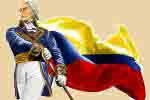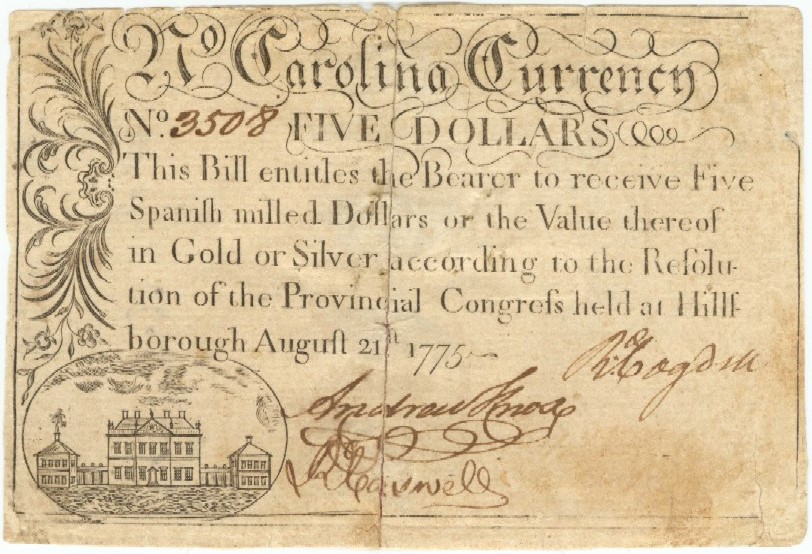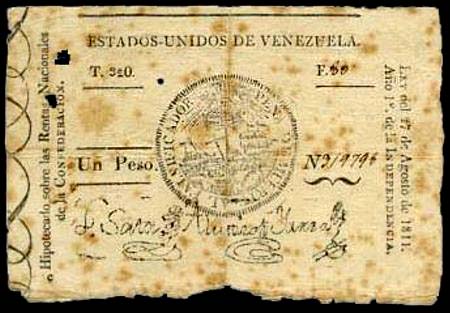|
General Francisco de Miranda,
A Latin American in the RevolutionBy: Miguel Chirinos, I.B.N.S. #5992, LANSA #1252
Recently I had the opportunity to visit the city of New Bern, the
second oldest city of North Carolina State. Named by the German and
Swiss settlers after the Swiss capital, Bern. Founded in 1710 by
German explorer Baron Christopher de Fraffenried; later New Bern was
also North Carolina's first capital.
Also, New Bern is the birthplace of a world famous soft-drink. In
1896, a phamacist invented the drink first known as Brad's Drink,
now popularly known as Pepsi-Cola. In the city th ere
are a lot of museums and historical sites. One of them is called
Tryon Palace. It was a state house during colonial times and accomadated
several illustrious people in the history of North America. ere
are a lot of museums and historical sites. One of them is called
Tryon Palace. It was a state house during colonial times and accomadated
several illustrious people in the history of North America.
During the visit to this site I was trying to find out more
details about this sensational building. But I observed that the
person who guided the tour mentioned several times the name of
General Miranda, an eminent Venezuelan patriot who participated in
some battles in North Africa as an officer of the Spanish Army and
also had a notable participation in the French Revolution.
But, who was this illustrious persona and how was he involved in
the American Revolution?
Francisco de Miranda was born on March 28, 1750, in Caracas,
Venezuela. Son of Don Sebastian de Miranda y Ravelo from the Canary
Islands and Francisca Rodriguez Espinoza, from a family that was
living in Venezuela for several generations. From 1764 to 1766 he
attended the "Class of Greater", deepening his knowledge of Latin.
Finally he attended "Arts", completing his education with logic
studies, physics and metaphysics, obtaining his Bachelor degree in
1767.
Early in life he entered the Spanish Army and went to Madrid,
supplied with ample funds and letters of introduction. He bought a
captaincy and began to keep the diary, which in time became the
nucleous of an immense archive. His military career was not
fortunate. After serving in Morocco and Alergia, where he
experienced heavy fighting for two years, Miranda returned to Spain
in 1779. Accused of neglect of duty, he was eventually cleared and
was sent to Cuba, where he again fell out with the authorities.
In 1781, he left the Spanish Army and fled to the United States.
He served under Bernardo de Galvez in the Spanish attack on
Pensacola, and Miranda received the surrender of the British and
cooperated in the capture of New Providence in the Bahamas, when
Spain was an ally of the rebels in the American Revolution.
While
in Cuba, Miranda played an important role in obtaining supplies and
organizing a fund-raising drive for the French Admiral de Grasse who
then sailed to the Chesapeake Bay to assist George Washington's
armies in the American capture of Yorktown.
In 1783, Miranda arrived in New
Bern, N.C. He had the opportunity to visit Tyron Palace, which
 combined
the governor's residence and statehouse, containing the assembly
hall, council chamber and public offices. This Royal Palace is
considered the most beautiful building in colonial times in North
America with the pure British style. Miranda noted that the palace
"really merits the traveler's attention". The architect, John Hawks,
gave some documents and letters to Miranda that year. A historian
discovered it in the Venezuelan archives in 1992. The engraving of
Tyron Palace appears on the $5.00 bills issued in North Carolina in
1775. combined
the governor's residence and statehouse, containing the assembly
hall, council chamber and public offices. This Royal Palace is
considered the most beautiful building in colonial times in North
America with the pure British style. Miranda noted that the palace
"really merits the traveler's attention". The architect, John Hawks,
gave some documents and letters to Miranda that year. A historian
discovered it in the Venezuelan archives in 1992. The engraving of
Tyron Palace appears on the $5.00 bills issued in North Carolina in
1775.
Henceforth, Miranda was in open rebellion against the Spanish
Crown. Spurred by the example of the 13 colonies that had achieved
independece from England, he aspired to set up an independent empire
in Hispanic America. He later visited Philadelphia and Boston. Among
his friends in the United States were such men as: George
Washington, Thomas Paine, Alexander Hamilton, also known as the
"Father of the Dollar", and other notable people.
Miranda traveled widely in Europe. Constantly hounded by Spanish
agents he visited England, Prussia, Austria, Italy, Turkey. In
Russia he bacame a favorite of Catherine II (The Great), who allowed
him to wear a Russian uniform and use a passport of this European
country.
In 1790, he offered his services to the French Army. In September
1792, as a general of division, he served under Charles Dumouiez in
the historic field of Valmy. Another victory, this time at Antwerp,
was followed by a debacle of the Republic's armies at Neewinden.
Tried on charges of treachery after his defeat, Miranda was
acquitted triumphantly. Later his name was inscribed at the Arc of
Triumph in Paris, and Miranda has become the unique Latin American
who appears on this solemn monument among those of the great
captains who fought in this revolution.
Before Miranda championed the independence of the Spanish
colonies, he involved himself in a number of adventures. When
Napoleon won control of France, Bonaparte said about him: "Miranda
is like a Quijote, except for the madness", however Miranda went
back to London. In 1797, he founded the American Lodge in London,
whose members swore their allegience to democracy and were to work
for the independence of the Spanish American colonies. In 1803,
Miranda discussed his plans with Prime Minister William Pitt, and he
received the support to carry out this important mission.
In 1806, Miranda organized an expeditionary force in New York,
with American, English, French, and Irish volunteers to invade
Venezuela. He decided to make an attempt at his own expense. Aided
by two American citizens, Col. William S. Smith and a civilian Mr.
Samuel Ogden, he equipped three ships with a group of 200 soldiers.
Informed of his intent, the Spanish met and defeated Miranda in the
Caribbean Sea. Miranda escaped to the West Indies where he prepared
another expedition.
Within a few months after his previous defeat, he was able to
take the city of Coro. He expected the Venezuelans to welcome him
and rise against the Spanish in imitation of the American, French
and Haitian revolutionaries. They did not find the necessary support
and received a very hostile reponse from the locals at Coro - the
mission failed. Miranda called the whole thing off and took refuge
in the Antilles and then in London, England.
While in London, Miranda taught mathematics, for he had
originally been a mathematician. Among his students were sons of the
future leaders in the fight for South American independence, such
as: Bernardo O'Higgins (Chilean), Antonio Narino (Colombian), Andres
de Santa Cruz (Bolivian), among others. Miranda was living on
Grafton Street No. 27, London and with Sarah Andres, who was his
housekeeper, had two sons: Leandro and Francisco. It was Napoleon's
invasion of the Iberian Peninsula (1808) that set the stage for
uprising in Hispanic America.
In addition, Miranda was the creator of the Venezuelan flag.
Later Colombia and Ecuador adopted the same colors and its symbols
of emancipation from Spain when it was hoisted on his ship "Leonder"
(this name inspired by his first son) on March 12, 1806.
In 1810, he met the envoy of revolutionary Venezuela, Simon
Bolivar. Bolivar induced Miranda to come back to his native country.
They returned together on December 5, 1810, to Caracas, where
Miranda organized the government that had its origin in the
revolution of April 19, 1810.
Gen. Miranda became Vice-President
of the Venezuelan Congress, and he sugg ested the issue of some bank
notes, (which were inspired by the "assignat" of the French
Revolution), of the following denominations: 1,2,4,8, and 16 Pesos.
In November of 1811, those notes were put into circulation, but
dated August 27, 1811. Those bills were printed by Juan Baillo and
Luis Delpach, official printers of the government of the First and
Second Republic. This first issue had the signature of three notable
Venezuelans such as: Juan German Roscio, Bartolome Blandin and
Martin Tovar Ponte, and those bills were known popularty as "Roscio,
Blandin and Tovar", printed over sealed paper of the republic. ested the issue of some bank
notes, (which were inspired by the "assignat" of the French
Revolution), of the following denominations: 1,2,4,8, and 16 Pesos.
In November of 1811, those notes were put into circulation, but
dated August 27, 1811. Those bills were printed by Juan Baillo and
Luis Delpach, official printers of the government of the First and
Second Republic. This first issue had the signature of three notable
Venezuelans such as: Juan German Roscio, Bartolome Blandin and
Martin Tovar Ponte, and those bills were known popularty as "Roscio,
Blandin and Tovar", printed over sealed paper of the republic.
One of these notable statemen, Juan Cerman Roscio, was born in
Caracas in 1769. he graduated in the study of law at the University
of Caracas in 1795, joined the revolutionists, and was elected
deputy to the Congress of 1811. He also edited the manifesto of the
Confederation of the Republic of Venezuela, assisted in forming the
Federal Constitution, and in 1812 was appointed a member of the
Federal executive. In 1818 Roscio published in Philadelphia his work
entitled, "Triumph of the Liberty ovr the Despotism".
During these times there also appeared a lot of counterfeits and
the government issued new bills with the legend "Death Penalty to
the Counterfeiter". The Republican paper money was not so popular.
Venezuelan humor made jokes with this. Grases gathered these
expressions: "Roscio, Bladin and Tovar were equivelent to sota,
horse, and king, in the deck and the game of golf". Other phrases:
"I sale a Roscio or the three reunited" or "If Roscio evicts me,
Baladin shrouds me and Tovar buried me".
On February 7, 1912, the republican government put in circulation
a second issue with the signature of Lorenzo de Sata, Jose Alustiza
and Jose Joaquin de Yarza. Other legends on these bills were:
"United States of Venezuela" and "First Year of the Independence". A
third issue replaced the second with the signatures of Sata, Yarza
and Sallcrup, but were in circulation just for two months because
the royalist took control of the country and those bills were burned
in the city of La Victoria. So Venezuela became the first country
which issued paper money in Spanish America.
After eloquent speeches by Miranda and Bolivar, the first
republic in South America was proclaimed in Caracas on July 5, 1811.
When the royalist armies threatened to destroy the young republic,
Miranda was elected Generalissimo and virtual dictator. But disunity
among the Venezuelans, the effects of a disastrous earthquake, and
the fall of the fortress of Puerto Cabello, forced him to capitulate
to the royalists headed by Monteverde on July 25, 1812, on the
condition that he should be deported to the United States, but the
condition was not observed.
Miranda was taken prisoner in San Carlos, and then he was sent to
the Castle of San Felipe, in Puerto Cabello. In June he was
transferred to El Morro, Puerto Rico. Finally, he was sent to Cadiz,
Spain in 1813. Gen. Miranda died in the dungeons of the inquisition
with a chain around his neck on July 14, 1816, the 27th anniversary
of the fall of the Bastile.
His remains never returned to his native country. When Gen.
Guzman Blanco was president of Venezuela, over sixty years after
Miranda's death, he built the National Pantheon to honor Venezuela's
heroes. A marble monument to Miranda, in the for4m of a coffin, was
placed in the Pantheon.
As a result of his contributions to the American Revolution, a
park in Pensacola, Florida, a statue in Philadelphia, Pennsylvania,
and a commuter bus in Chicago, Illinois, were dedicated in his
honor.
On the 5 Bolivares (1968) Bolivar is at the left and Miranda at
right. A view of National Pantheon is on back. Recently Banco
Central de Venezuela issued a note of 5,000 Bolivaries (2000) where
there appears Francisco de Miranda at right. The portrait is
inspired by a work of the French painter Georges Rouget (1783-1869),
which is in the National Museum of Versailes, France. So this bank
note is in tribute to this notable patriot who eventually took part
in revolutions on three continents.
References:
Billetes de Venezuela, by Richard L. Rosenman, 1980
Enciclopedia of World Biography, 2nd Edition, Studl Visser,
1998
Dictory of Histpanic Biographies, 1986
Latin American Heroes, by Jerome R. Adams, 1993
A Tryon Treasury, by Taylor Lewis and Joanne Young, 1992
Collaborators: A. Velasco and M.
Balladares
|